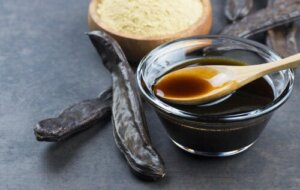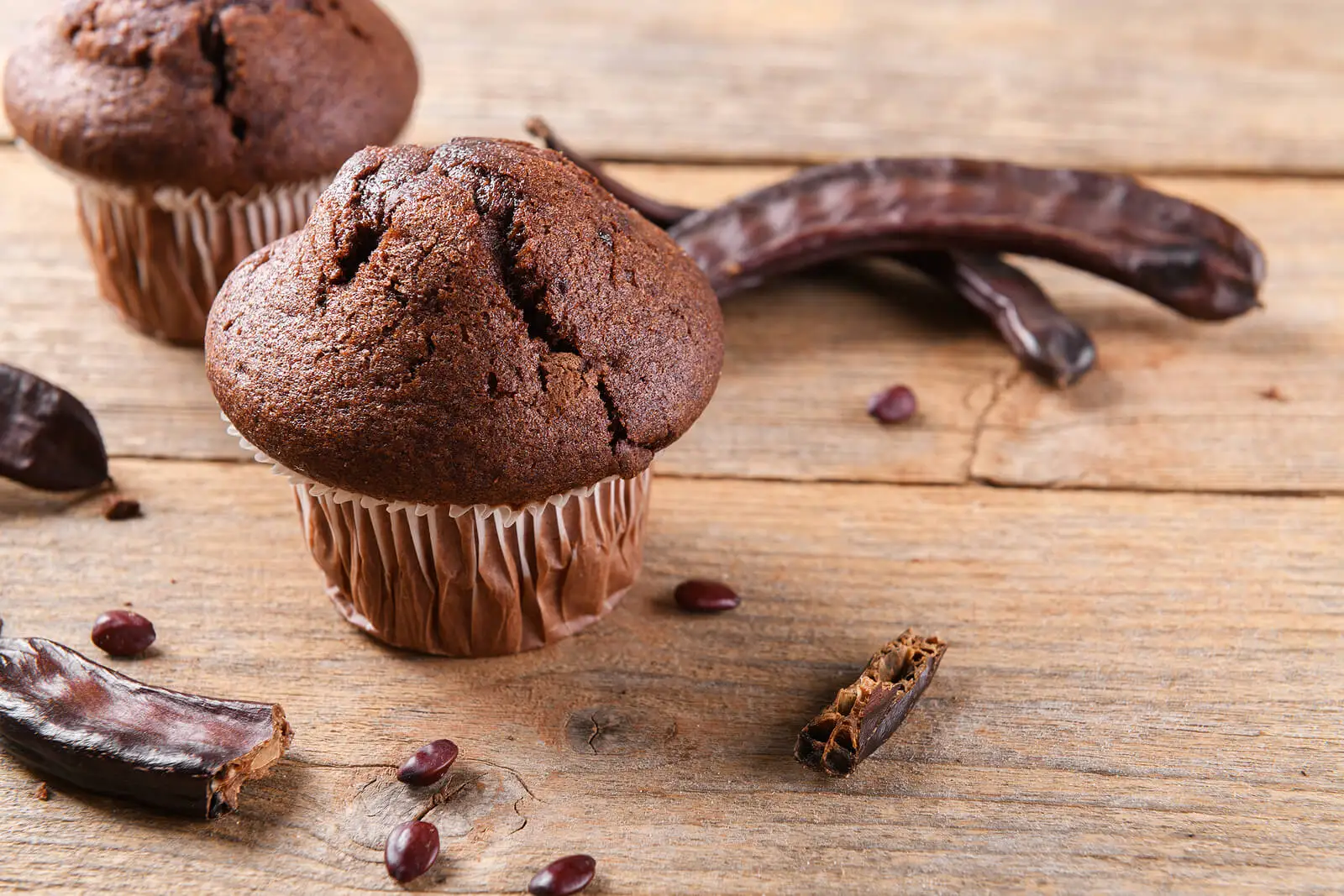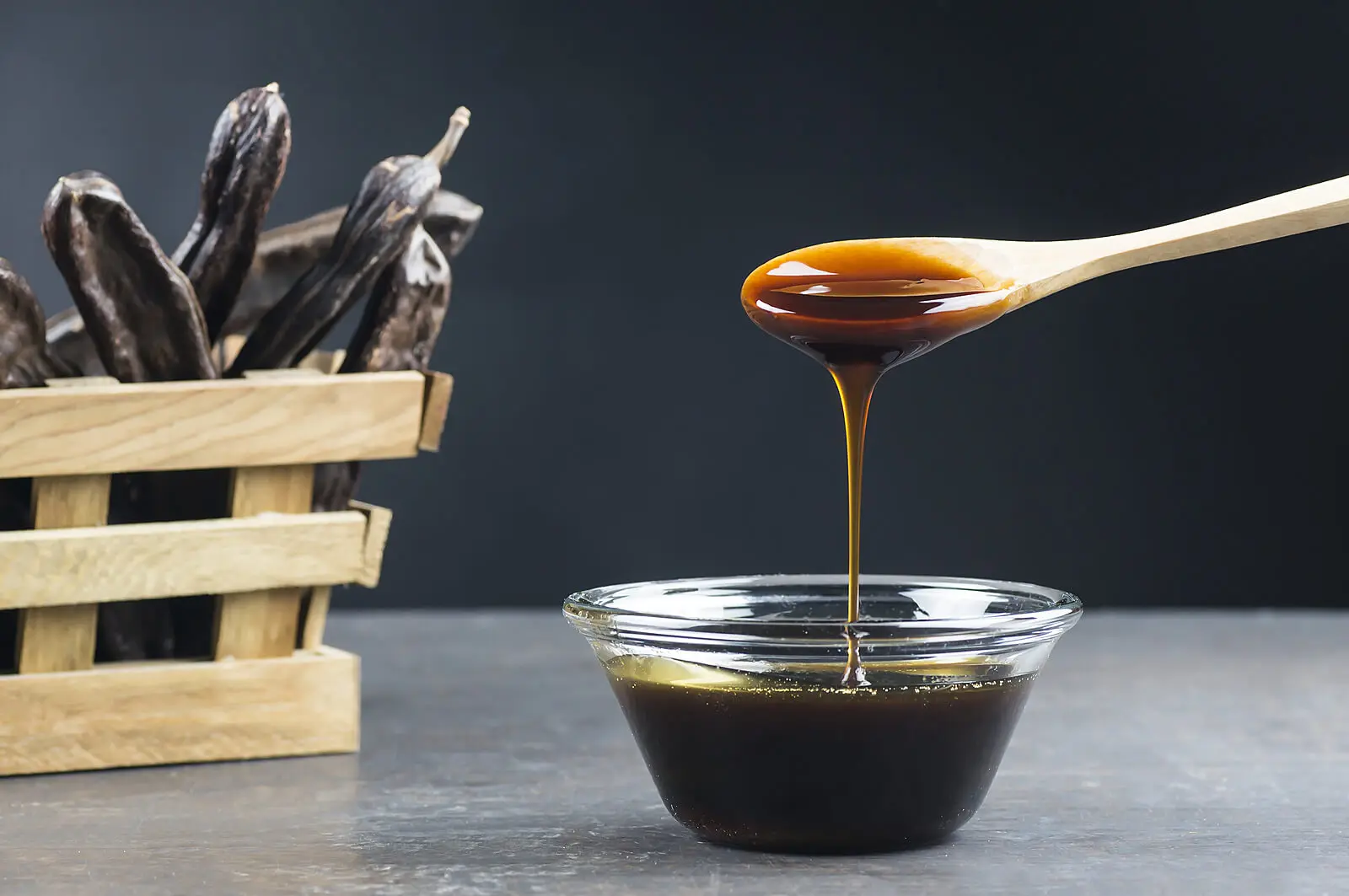Carob Bean Gum: Nutritional Value and Benefits


Written and verified by the nutritionist Maria Patricia Pinero Corredor
Carob bean gum, as its name implies, comes from the seeds of the carob tree (Ceratonia siliqua). It’s a food additive of natural origin that is used as a thickening and stabilizing agent in foods such as ice cream, yogurt, and cream cheese.
And, although it isn’t as well known, it’s often mixed with xanthan gum or carrageenan to obtain a thicker food. In sweetened products it enhances its effect; in addition, in frozen products, it helps delay the formation of ice crystals. What is its nutritional value? What are its benefits? Find out here!
Nutritional value of carob bean gum
The United States Department of Agriculture (USDA) states that carob bean gum contains the following:
- Calories: 94.1 kcal.
- Fat: 0.135 grams.
- Sodium: 35.4 milligrams.
- Protein: 1.3 grams.
- Fiber: 21.9 grams.
- Sugars: None.
These measurements are for 28 grams, which represents one ounce. They’re expressed this way because what is usually used is one or two tablespoons, even three if applied to a cold food such as ice cream.

Read also: Vegan Whole Wheat Sponge Cake Recipe: Step by Step
Carob bean gum benefits
Carob bean gum is known to have a thickening effect, although few know about its health benefits. We’ll tell you more about what science says about it.
It could regulate blood lipids
This gum contains a substance called “galactomannan polysaccharides”, which is a type of soluble fiber. That is what allows the products to thicken and gel when it’s added to them. Moreover, it’s a fiber linked to lowering bad blood cholesterol (LDL).
-
Human studies
In this sense, in research in adults with high cholesterol, it was observed that the daily ingestion of 15 grams of carob fiber, for 6 weeks, reduced “bad” cholesterol or LDL by 12 percent and total cholesterol by 7 percent.
There are 2 mechanisms that explain this effect. One, it occurs directly, when the mucilage-like fiber of carob gum forms a gel in the intestine that traps dietary cholesterol which is produced within the body itself. It is then excreted in the feces.
The indirect form occurs when the gum excretes the bile salts that are released to digest fats. These are produced from cholesterol in the liver. So, the more bile is excreted, the more cholesterol will be needed to produce them again, generating a cycle between the intestine and the liver. In the end, LDL cholesterol in the blood is also reduced.
-
Animal studies
Experiments in animal models also seem to support these results. A study that analyzed the effect of carob fiber on fat digestion in healthy rats determined that this substance favors the reduction of blood lipids. And this effect was observed after the fats were digested and absorbed.
Another test performed on rabbits indicated that the insoluble dietary fiber in carob abundant in polyphenols could reduce the development of atherosclerosis.
The results suggested that carob fiber is able to decrease mixed dyslipidemia by increasing the levels of liver enzymes involved in cholesterol and triglyceride metabolism. More human studies are needed to confirm the effect of carob bean gum on diseases related to blood lipid disorders.
Find out more about the Characteristics, Types, and Function of Lipids
Protects and feeds the intestine
Carob bean gum contains galactomannans, a type of soluble fiber that favors the growth of intestinal microflora. A group of experts has affirmed this (article in Spanish). This fiber decreases the growth of disease-causing bacteria while increasing beneficial bacteria, called lactobacilli.
In the Spanish magazine NutriNews they explain that galactomannans bind to intestinal bacteria, preventing them from sticking to the walls of the intestine and, consequently, blocking their overgrowth. Bacteria such as Salmonella and E. coli reduce the risk of infections while the rest of the microflora keeps intestinal functions intact.
In addition, this soluble fiber has a prebiotic effect, nourishing lactobacilli and promoting their growth. In this way, they act directly on the function of the intestinal barrier under normal conditions and during exposure to harmful bacteria to the body.
It has anti-reflux activity
The thickening effect of carob bean gum has been reported to improve the feeding of infants with reflux problems. In this regard, it has been found that, by reducing the usual concentration of this gum in the formula, it has the same effect as when used in the standard concentration. Babies decreased regurgitation by at least 50 percent.
Another study compared the efficacy of infant formula milk with and without carob. In particular, 56 eligible infants, between 1 and 6 months of age, were randomly assigned to receive formula with different concentrations of galactomannan for two weeks.
It turned out that only infants who received the formula milk with 0.33 grams of galactomannan per 100 milliliters, diluted while cold, decreased reflux, gained weight, and improved tolerance. Whereas proportions of 0.45 grams per 100 milliliters of formula, diluted both cold and hot, did not improve symptoms.
To be more precise, 0.33 grams per 100 milliliters of cold galactomannans was effective in reducing reflux rates. Moreover, they were well tolerated by infants.
Further research on infants who consumed formulas with 0.350 grams of carob gum, another with 0.450 grams and another group without the product reported that only those who consumed carob gum had an improvement with gastric reflux.
Possible anti-diabetic effect
In 2015, a study on products made with carob flour revealed that all had a low glycemic index and glycemic load. The high insoluble fiber content of this flour decreases intestinal transit time, increases fecal bolus, and slows sugar absorption and starch breakdown. In this way, the sugar is absorbed progressively in the blood.
On the other hand, in research on rats, it was observed that carob bean gum can reduce glucose levels in the blood and, incidentally, increase the glycogen content of the liver. Another similar study found that this product is able to reduce hunger and blood sugar.
However, there aren’t many studies in humans to corroborate these effects.

Carob bean gum contraindications
For now, carob bean gum is considered safe for most healthy adults. Experts only recommend you avoid contact with this substance in cases of allergies. However, no cases of allergy have been reported due to its ingestion. Its consumption in large quantities should be avoided, as it tends to cause flatulence.
And to summarise…
Carob bean gum isn’t just a simple food additive. Aside from the consistency it can give to recipes, it also appears to have positive effects in relieving reflux and lowering cholesterol and blood sugar.
A very interesting aspect is that only small amounts are required to achieve its effects. For example, only a 0.35-gram serving is capable of having anti-reflux effects in infants.
All cited sources were thoroughly reviewed by our team to ensure their quality, reliability, currency, and validity. The bibliography of this article was considered reliable and of academic or scientific accuracy.
- Macho-Gonzalez A, Garcimartin A, Naes F, Lopez-Oliva ME, Amores-Arrojo A, Gonzalez-Munoz MJ, et al. Efectos del extracto purificado de fibra de algarrobo sobre la digestión de grasas y la lipemia posprandial en ratas sanas. J Química alimentaria agrícola. 2018;66(26):6734–41.
- Valero-Munoz M, Ballesteros S, Ruiz-Roso B, Perez-Olleros L, Martin-Fernandez B, Lahera V, et al. La suplementación con una fibra insoluble obtenida de la algarroba ( Ceratonia siliqua L.) rica en polifenoles previene la dislipemia en conejos a través de la vía SIRT1/PGC-1alfa. Eur J Nutr. 2017;58(1):357–66.
- Wang LH, Zhang J, Yang YL, Chun LI, Da-Li XU, Chen WL. Efecto de la goma de algarrobo sobre el glicometabolismo en ratones. Acta Nutrimenta Sínica. 2009.
- USDA. Locous beam gum. https://fdc.nal.usda.gov/fdc-app.html#/food-details/169045/nutrients
- Forestieri AM, Galati EM, Trovato A, Tumino G. Efectos de las gomas de guar y algarrobo sobre los niveles plasmáticos de glucosa, insulina y colesterol en ratas. Phytother Res. 2010;3(1):1–4.
- Zavoral JH, Hannan P, Fields DJ, Hanson MN, Frantz ID, Kuba K, et al. El efecto hipolipidémico de los productos alimenticios de goma de algarrobo en adultos y niños con hipercolesterolemia familiar. Soy J Clin Nutr. 1983;38(2):285–94.
-
HABER, B.. Fibra de Algarroba: mucho más que fibra alimentaria. En: Alimentación Equipos y tec-nología. Vol 22, N° 183, (2003); p. 95-99
-
Alzate Tamayo, Luz María;Arteaga González, Diana María;Jaramillo Garcés, Yamilé. Propiedades farmacológicas del Algarrobo (Hymenaea courbaril Linneaus) de interés para la industria de alimentos. Revista Lasallista de Investigación, Vol. 5, Núm. 2, julio-diciembre, 2008, pp. 100-111
- Efectos protectores de los β-galactomananos vegetales sobre la función barrera intestinal. Revista NutriNews Junio 2016. Disponible en: https://nutrinews.com/efectos-protectores-de-los-%CE%B2-galactomananos-vegetales-sobre-la-funcion-barrera-intestinal/
- Luciana Milek dos Santos, Lindamir Tomzack Tulio , Leticia Fuganti Campos , Marcelo Ramos Dorneles and Cláudia Carneiro Hecke Krüger. Glycemic response to Carob (Ceratonia siliqua L) in healthy subjects and with the in vitro hydrolysis index. Nutr Hosp. 2015;31(1):482-487.
This text is provided for informational purposes only and does not replace consultation with a professional. If in doubt, consult your specialist.








